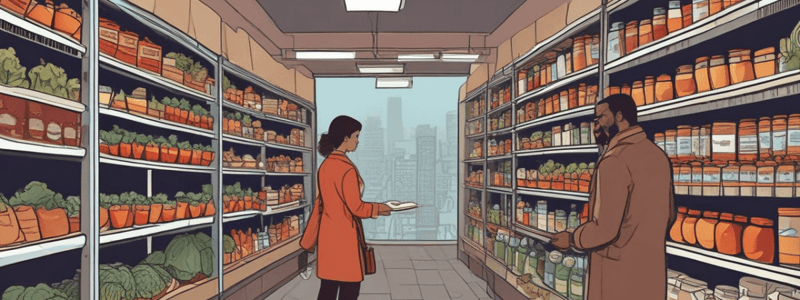Podcast
Questions and Answers
Food insecurity has no impact on a patient's ability to follow a meal plan recommended by their provider
Food insecurity has no impact on a patient's ability to follow a meal plan recommended by their provider
False (B)
Healthcare providers do not need to screen patients for food insecurity in eating disorder treatment
Healthcare providers do not need to screen patients for food insecurity in eating disorder treatment
False (B)
Patients with food insecurity are less likely to report feeling misunderstood by their treatment providers
Patients with food insecurity are less likely to report feeling misunderstood by their treatment providers
False (B)
There is no correlation between food insecurity and the likelihood of taking prescribed medications
There is no correlation between food insecurity and the likelihood of taking prescribed medications
Screening for food insecurity is already a standard part of the intake process for eating disorder treatment
Screening for food insecurity is already a standard part of the intake process for eating disorder treatment
Flashcards are hidden until you start studying
Study Notes
Food Insecurity
- Food insecurity is defined as limited or uncertain access to an adequate amount of food for all persons in a household to meet their nutritional needs.
- In 2022, 44.2 million people in the United States, including 7.3 million children, lived in households with food insecurity.
- Food insecurity is more prevalent among individuals and families with children or older family members, racial and ethnic minorities, and single female households with one or more children.
- Food insecurity is higher in urban and rural areas with limited access to nutritious foods, known as food deserts, and/or areas with only access to inexpensive non-nutritious foods, known as food swamps.
Health Consequences of Food Insecurity
- Food insecurity is linked to an increased risk of mortality and health conditions such as cardiovascular disease, hypertension, asthma, migraine, and worsening of type 2 diabetes.
- Food insecurity is also linked to impaired development and growth, cognitive deficits, and increased risk of anxiety disorders, depression, suicide ideation, sleep problems, eating disorders, and disordered eating.
Link Between Food Insecurity and Eating Disorders
- People with food insecurity are more likely to exhibit disordered eating behaviors, including obsession with food, restriction, binge eating, and compensatory behaviors.
- Food insecurity is associated with a higher risk of bulimia nervosa (BN) and binge eating disorder (BED).
- Studies have found that food insecurity is strongly linked to disordered eating and eating disorders across the lifespan.
Treatment Considerations
- Many people with eating disorders cannot access treatment due to a lack of financial resources, which is even more prevalent among those experiencing food insecurity.
- Individuals experiencing food insecurity may not be able to follow recommended treatment plans due to lack of access to food and medications.
- Healthcare providers should be aware of the link between food insecurity and eating disorders and screen patients at greater risk of food insecurity for eating disorders.
Studying That Suits You
Use AI to generate personalized quizzes and flashcards to suit your learning preferences.



